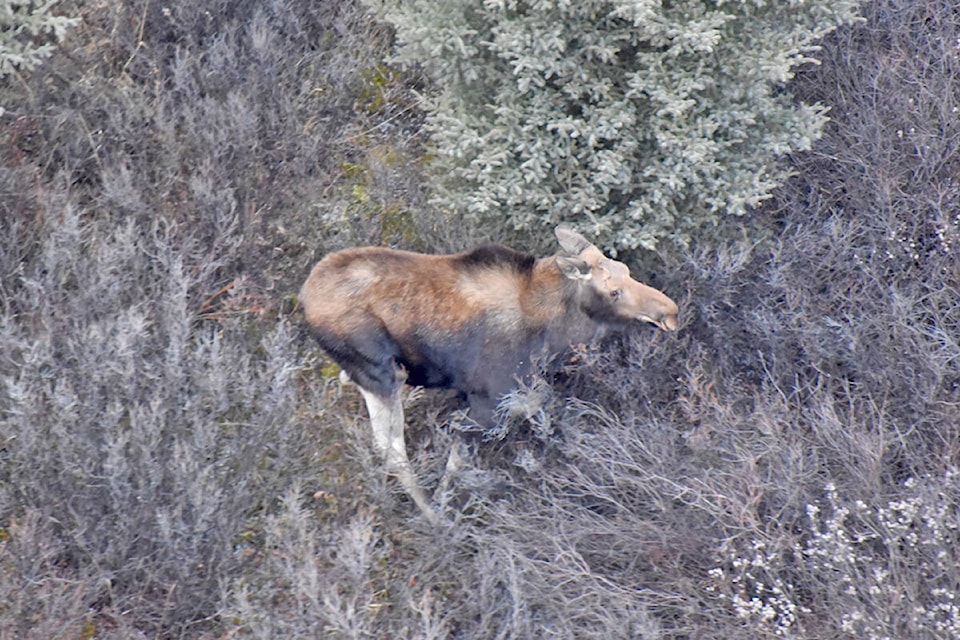Moose hunters in Region 5 west of Williams Lake were the target of an enhanced enforcement project carried out by the Conservation Officer Service this fall.
For the second year in a row the project saw officers take to the air three or four times per month since September to police hunters and find potential poachers during the annual moose hunt.
The moose harvest has been the subject of much concern in recent years due to a significant drop in moose populations across Interior and Northern B.C., increasing pressure from local First Nations to reduce the number of Limited Entry Hunts handed out and a need to protect the animals since their landscape was altered during the 2017 wildfires.
“This is work above and beyond what we normally would do and the primary objective is to monitor the moose hunt through the Limited entry Hunts and the First Nations hunt for moose that goes on at the same time,” said COS Sgt. Jeff Tyre, who flew in a helicopter last week along with COS Ron LeBlanc on a day-long aerial patrol that took them from Canoe Creek in the south, to Big Creek, Nemiah Valley and Fletcher Lake in the west and across Hanceville to the Raven Lake and Fir Lake areas.
“The long-term of this is we are finding out where the camps are now, then next year at the same time we’ll know exactly where to go by vehicle patrols and be more efficient. And we’re gathering a significant amount of intelligence while we are out there.”
Read More: B.C. Interior First Nations announce limited-entry moose hunt ban
The aerial patrol last week saw officers patrolling several logging roads looking for hunters as well as finding remote moose camps “and just dropping in unexpectantly.”
The method also allows officers to cover vast areas by air that would take them several days by ground, and familiarizes them with areas of the backcountry they may not have known of otherwise.
“It’s one thing to patrol the area by truck but seeing the area from a helicopter gives you a whole new perspective on where the camps are, which roads they’re using to access, which ones are being used more frequently by hunters and by the game so that you get a better idea of where we should focus our energy,” said LeBlanc.
“We don’t usually get a lot of helicopter time so we are using the opportunity to have the helicopters as best as we can … it is a great tool for us to use.”
Father and son moose hunters Brian and Steve Brewster have been coming to the Chilcotin to hunt for years and were surprised when they were stopped on a back road by the officers via helicopter.
“This is a first. But to be honest I’m glad to see you out here, if you want to know the truth. There’s nothing to worry about if you’re by the book,” said Brian, who is from the Lower Mainland.
After seeing hunters outside a cabin, Tyre and LeBlanc had the helicopter land just outside the remote property and they conducted another ground search where a group of hunters were unpacking for a week-long moose hunt with family members.
“This is my son over here, and I’m just teaching him right and we always do everything that we can so there’s going to be something left over for my grandchildren,” said Ken Ekstrom.
Flying away from the cabin, LeBlanc was quick to point out hunters aren’t always that accommodating.
“All the checks today have been with hunters who are welcoming, honest and cooperative, which is nice but those aren’t the guys we’re looking for. It’s the guys who are intentionally trying to skirt the law who are the ones we’re after.”
Tyre said hunters in Region 5 can continue to expect the unexpected when it comes to how and when the COS will conduct hunting patrols to help protect the moose populations.
The LEH for moose is closed Nov. 15 in Region 5, however, First Nations can hunt year-round.
Tyre said the COS is assisting local First Nations governments on complaints of cow moose harvests, something leaders are trying to stop.
The enhanced enforcement project west of Williams Lake this fall has resulted in more than 40 violation tickets being issued and over 50 warnings being handed out. Tyre noted several firearms were also seized and one 24-hour roadside prohibition was given out.
Several harvested animals, including one moose, were also seized due to hunting infractions. That meat was donated to First Nations communities and those in need.
Do you have a comment about this story? email:
editor@wltribune.com
Like us on Facebook and follow us on Twitter.
